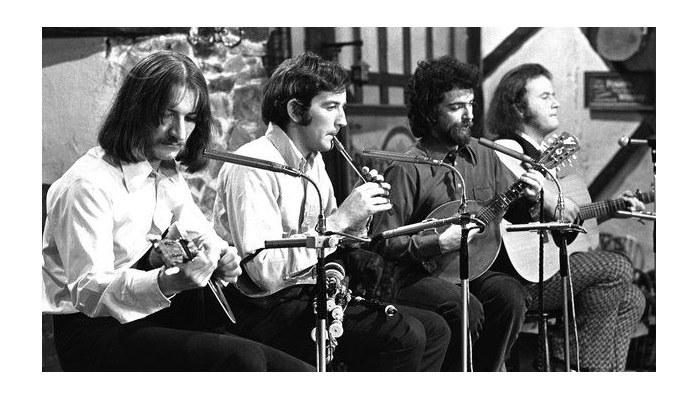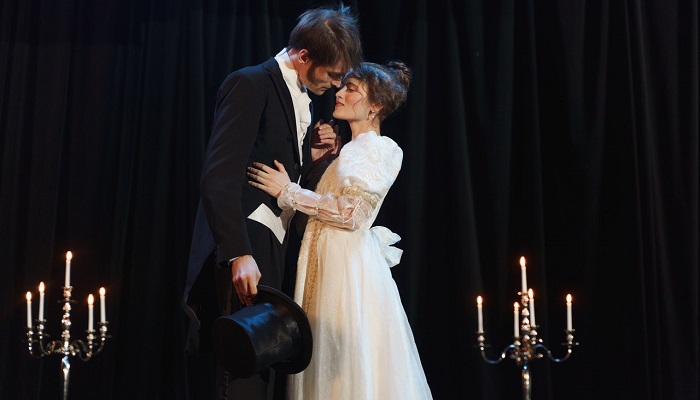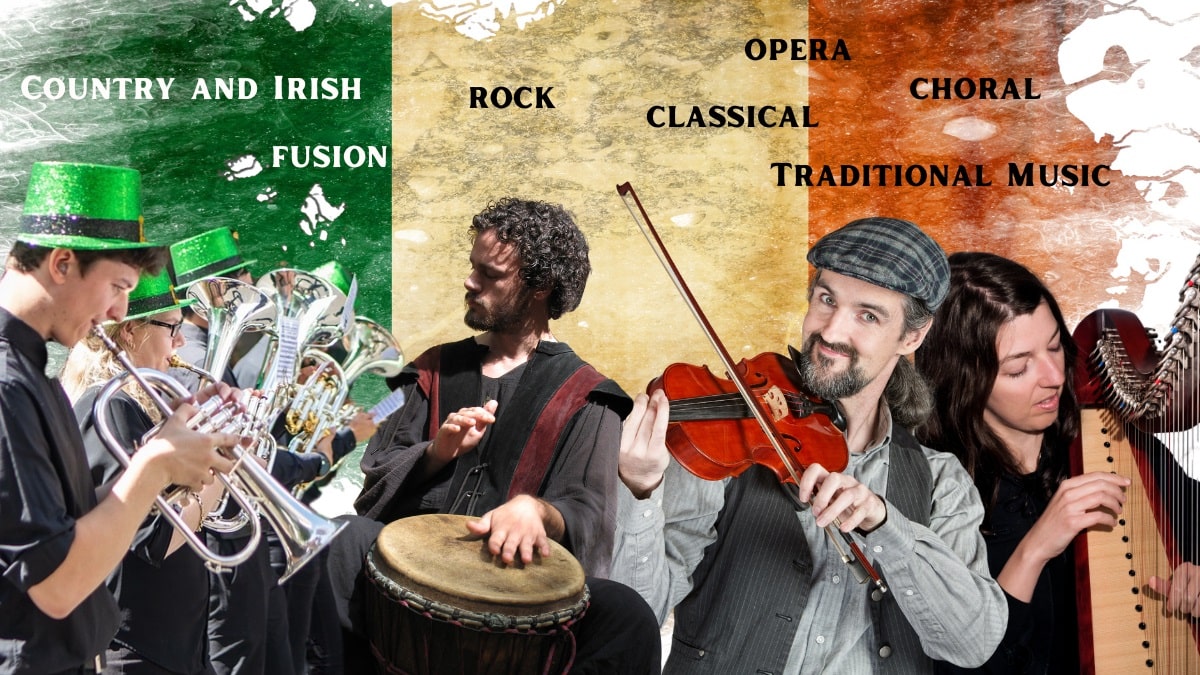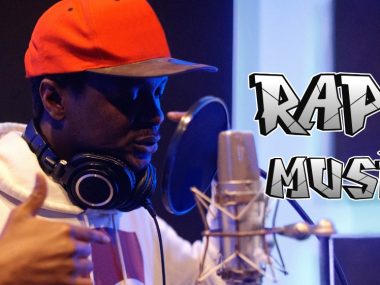Did you know that the Irish Euro features a harp on one of its sides?
The harp has been Ireland’s traditional symbol since the middle ages. Yes, that’s how much the Irish folks value their music.
They created their version of most music genres on the scene, including Pop, Rock, and Country. They also fused their traditional music with a number of genres—even heavy metal!
In this article, we’ll list all types of Irish music, giving you an all-inclusive view of Ireland’s imprint on music genres worldwide.
Country and Irish

Country and Irish is a subgenre of American Country music, popular in the country’s North West and rural Midlands. It developed by incorporating Irish folk music in American Country. In a way, Country and Irish songs are merely traditional Irish songs sung in a country style.
The first artists who adopted this music genre are the country showband Big Tom and The Mainliners. They rose to popularity in the ‘60s during the showband era, and they were among the earliest bands to sing Country and Irish.
Later on, other artists carried the flag, including Philomena Begley, who the fans called ‘Queen of Country of Irish.’
Still, the most successful artist of Country and Irish remains Daniel O’Donnell, who rose to popularity in the US, UK, and Australia, aside from his home country, Ireland. His popular singing partner, Mary Duff, also adopted the country genre, and it brought her huge success.
Fusion
Fusion is a musical term known as the blending of two or more music genres to create a whole new style. The Irish mastered the genre and managed to fuse their popular traditional music with a number of modern musical styles.
For instance, Sean O’Riada may have been the first Irish artist to fuse two genres. He incorporated Irish folk with classical music pieces, such as Mise Eire. Irish folk music was played in an orchestra, which was a first in Ireland back then, although Vaughan Williams did the same in England.
O’Riada didn’t carry on with fusion music, but he influenced multiple artists to carry the flag later. For example, the Irish folk band Planxty and the Chieftains was inspired by his work and steered it in another direction by fusing traditional Irish music with contemporary folk. Later on, they incorporated music from a lot of places around the world, including Nashville and China.

Ed Sheeran once said he grew up listening to the Planxty, so they may have inspired his successful musical career as well.
Another successful example of Irish fusion music is Afro-Celt, which was created by Simon Emerson, the founder of the Afro-Celts Sound System band. The genre mixes West African music with Irish music, adding some modern dance beats.
The band was nominated for a Grammy, and their popularity surged soon after.
Lastly, there’s the fusion band, Kila, who mixed traditional Irish music with rock. The band went on to represent the Irish music at many music festivals across the globe.
Rock
Rock Irish music surged in popularity in the ‘60s, when rock artists brought a lot of genres to the island with the British Invasion musical phenomenon. Some styles like psychedelic rock and blues arrived in Ireland, laying the foundation for what was known later as Irish rock.
In the ‘60s and ‘70s, the Irish music scene was dominated by showbands, who performed at clubs and dancehalls, playing the famous British hits then. From then, Rock Irish music was born, following the same direction as England’s Rock music.
A lot of Irish rock stars emerged in that era, including Gary Moore, Them, Eire Apparent, Rory Gallagher, and Van Morrison. Nearly a decade later, Irish rock and pop music was brought to Europe’s top tracks, thanks to Dana’s song that spread worldwide, All Kinds of Everything.
The song won the Eurovision Song Contest and got a leading position in the UK and most European countries. It was a personal achievement for the artist, but it paved the way for a lot of Irish rock artists to follow.
Dana wasn’t the only one; Gilbert O’Sullivan also reached the top of the charts in 1972 with a number of hits. Additionally, Chris de Burgh leaped to success with his hit, Lady in Red.
Ireland’s effect on rock music didn’t stop here. In the ‘90s, a subgenre called folk metal was born. It was practically folk music fused with heavy rock metal, and a lot of bands adopted it, including Primordial and Waylander.
Traditional Music
Traditional Music is Irish’s most popular genre, and it’s the umbrella that all the other genres went out from. Some people call it folk music or Irish Celtic music.
One of the many interesting facts about it is that it started as an oral tradition. The tunes weren’t written on paper but instead listened and learned by ear.
Traditional music goes way back to the 5th century when Saint Patrick landed in Ireland and started teaching people Gallic hymns. The harp instrument was introduced to the Irish in the same period, and it became an iconic symbol for the country, integrating into all Irish genres.
Some people believe the harp originated in the Celtic countries, and others think the first ones to use it were the Ancient Egyptians. Either way, if there’s a country that made harps live forever, it’s undoubtedly Ireland.
There are a lot of characteristics defining traditional Irish music. For example, the main instruments are harps, bodhran drums, and tin whistles.
Additionally, some modes are almost always used, such as the Dorian and Mixolydian. There are also main musical keys, which are D, G, C, and A. The most common ones are D and G
Traditional music went through a slump in the ‘40s and ‘50s before regaining popularity back in the ‘60s. A lot of artists were to thank for the revival, including Sean O’Riada, The Chieftains, The Irish Rovers, and Tom Lenihan.
In fact, O’Riada alone did most of the job. He served as an inspiration for many bands that peaked in the ‘70s, including Planxty and Clannad.
In the 20th century, traditional Irish music went through another revival, adding more instruments like the concertina and the accordion.
Classical

Classical music has been a staple in Ireland since the 15th century when the Christ Church Cathedral established a polyphonic choir.
It regained its glamour in the 18th century, with significant musical events coming out, such as George Handel’s famous performance, Messiah.
The music has been shaped then by many factors, including the Catholic charge, the infamous potato famine, and British Colonialism. Most of Ireland’s composers then were part of the Anglo-Irish Protestant community. Their careers weren’t limited to the island, but their studies extended to Germany, the UK, and Russia, as well, because there were better opportunities.
Among these composers are Michael William Balfe, John Field, and Charles Viliers Stanford.
Decades later, in the 20th century, classical music was affected once again by political change. The Church started loosening its grip, which led to a lot of cultural change on the island.
For instance, a lot of women began composing, which wasn’t allowed before. Additionally, some emigrant composers emerged, taking Ireland as their refuge.
Famous Irish performers include Catherine Hayes, who’s the first woman to perform at La Scala, Milan. There’s also the tenor Joseph O’Mara, the pianist Charles Lynch, and the tenor Barton McGuckin.
Choral
Choral music started in Ireland at large churches, including Saint Patrick’s Cathedral, St Mary’s Pro-Cathedral, and Christ Church Cathedral. The music took a new direction in 1987 when Michael McGlynn composed and directed Anúna, the worldwide popular choral ensemble.
The show’s featuring in Riverdance contributed significantly to its fame, which reflected on the country’s choral culture. It was even nominated for a Classical Brit Award, which put it on the map of choral music worldwide.
Today, Ireland’s choral ensemble, the Chamber Choir Ireland, still contributes to the musical genre through repertoire spans inspired from the Renaissance Era. A lot of semi-professional choirs are playing the music as well, and a lot of them perform annually at the Cork International Choral Festival.
Opera

Ireland has been hosting Opera shows since the 17th century. In fact, the country was the world’s center for ballad opera in the 18th century, especially after the Celtic Renaissance.
Opera pieces like Connla of the Golden Hair and Muirgheis live on till today. That’s aside from the less popular pieces, such as Eithne and The Thinker and the Fairy.
On top of that, some Irish artists’ contributions steered the genre in the direction of Operetta. These artists include Kane O’Hara and Charles Coffey.
Opera in Ireland was majorly affected by immigrants, including Johann Bernhard Longler and Tommaso Giordini. Their works are nationally identifiable till today. That’s aside from the native composers, who also left their imprint on the genre, including Thomas Simpson Cooke and John Andrew Stevenson.
In the ‘60s, Opera in Ireland started taking a contemporary direction with some pieces by James Wilson, Raymond Deane, and Gerald Barry.







